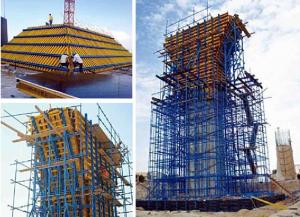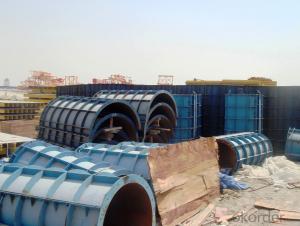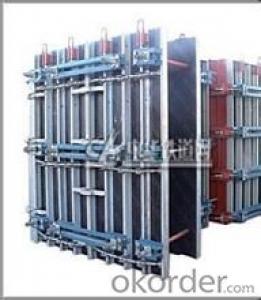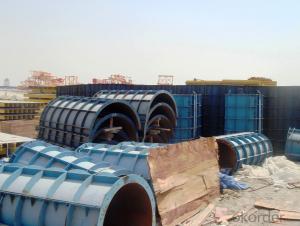Steel-frame Formwork
- Loading Port:
- XINGANG
- Payment Terms:
- TT or LC
- Min Order Qty:
- 55 Cubic Meter/Cubic Meters m.t.
- Supply Capability:
- 5000 Cubic Meter/Cubic Meters per Month m.t./month
OKorder Service Pledge
OKorder Financial Service
You Might Also Like
Quick Details of Steel-frame Formwork
Type: Plywoods
Place of Origin: China (Mainland)
Brand Name: CMAX
Usage: Outdoor
Grade: First-Class
Main Material: Poplar
Formaldehyde Emission Standards: E1
Plywood Type: 13-Ply Boards
Film: black,brown,red,anti-slip
Core: poplar,hardwood,eucalyptus,combi,birch
Glue: melamine WBP,phenolic
WBP Size: 1220*2440mm,1250*2500mm
Thickness: 9mm,12mm,15mm,18mm,21mm
Pressing: 1 time,2 times
Packaging & Delivery Steel-frame Formwork
Packaging Detail: inner with plastic bag,outer with carton board or thin plywood then fastened by steel belts with pallet
Delivery Detail: Within 15 days after receiving deposit or original L/C at sight
Specifications Steel-frame Formwork
1)Film:brown,black,red,anti-slip
2)Core:poplar,hardwood,combi,birch
3)Glue:melamine WBP,phenolic WBP
4)Useage:construction
Item | Film faced plywood/Marine plywood/Construction plywood | |
Face/Back | Brown film,Black Film,Red film,Anti-slip film | |
Core | Poplar,hardwood,Eucalyptus, Poplar, Birch | |
Glue | Melamine WBP glue,Phenolic WBP glue | |
Size(mm) | 1220×2440mm,1250×2500mm or as request | |
Thickness(mm) | 9mm,12mm,15mm,18mm,21mm | |
Moisture | 6-12% | |
Thickness tolerance | +/-0.5mm
| |
Packing | inner with plastic bag,outer with carton board or thin plywood then fastened by 4×6 lines steel belts with pallet | |
Quantity | 20’GP | 8 plts/22M3 |
40’GP | 16 plts/48M3 | |
40’HQ | 18 plts/55M3 | |
Useage | Using for making construction, industry | |
MOQ | 1×40'HQ | |
Payment Terms | TT:30% deposit, the balance agaist B/L copy L/C: irrevocable L/C at sight | |
Delievery Time | Within 15 days after receiving 30% deposit or original L/C at sight | |
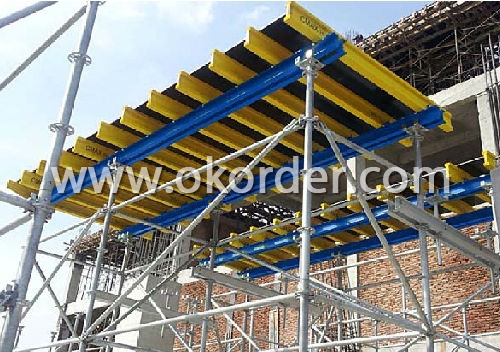

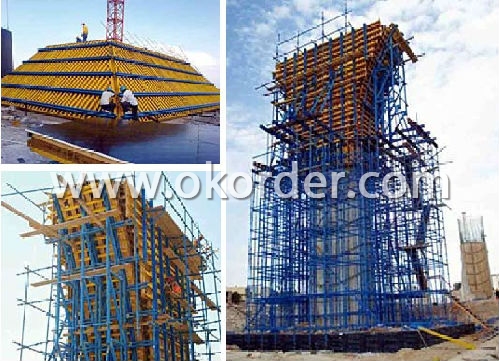
- Q:How does steel frame formwork handle the placement of mezzanines and elevated platforms within the concrete structure?
- An efficient and versatile system for handling the placement of mezzanines and elevated platforms within a concrete structure is steel frame formwork. This type of formwork is specifically designed to provide support and stability during the construction process, enabling the creation of various structural elements such as mezzanines and platforms. The steel frame formwork is composed of interconnected steel panels that are assembled to form a rigid framework. These panels are flexible and can be easily adjusted to accommodate different shapes and sizes required for mezzanines and elevated platforms. Moreover, the formwork is adjustable, allowing for changes in height and width to meet the specific requirements of the structure. During the construction of a mezzanine or elevated platform, the steel frame formwork is set up and firmly anchored to the surrounding concrete structure. This establishes a stable and secure platform for workers to access and work on the construction site. The formwork is then precisely aligned and adjusted to achieve the desired height and shape of the mezzanine or platform. Once the formwork is in position, the designated area is filled with concrete, filling the space created by the formwork. The steel frame formwork acts as a mold, confining the concrete and providing the necessary support during the curing process. The formwork is designed to withstand the pressure exerted by the concrete, ensuring that the mezzanine or platform maintains its intended shape and structural integrity. After the concrete has fully cured and hardened, the steel frame formwork can be safely dismantled. This results in a solid, durable, and precisely formed mezzanine or elevated platform within the concrete structure. The formwork can then be reused for future construction projects, making it a cost-effective and sustainable solution. In conclusion, steel frame formwork is an excellent option for handling the placement of mezzanines and elevated platforms within a concrete structure. Its versatility, adjustability, and stability make it an efficient and dependable system, guaranteeing the successful construction of these structural elements.
- Q:What are the different types of formwork leveling systems used with steel frame formwork?
- There are several types of formwork leveling systems used with steel frame formwork, including adjustable props, leveling jacks, shims, and wedges. These systems are used to ensure that the formwork is accurately leveled and aligned before concrete pouring, allowing for the construction of strong and stable structures.
- Q:What types of projects are steel frame formwork commonly used for?
- Steel frame formwork is commonly used for various types of projects, such as high-rise buildings, bridges, tunnels, and large-scale infrastructure projects. It provides a sturdy and reliable structure that can withstand heavy loads and ensure the efficient construction of concrete elements.
- Q:Are there any specific considerations for using steel frame formwork in industrial construction projects?
- Yes, there are several specific considerations for using steel frame formwork in industrial construction projects. Firstly, steel frame formwork offers high strength and durability, making it suitable for large-scale and heavy-duty applications commonly found in industrial projects. Additionally, steel formwork provides excellent dimensional accuracy, ensuring precise and consistent results. It is also fire resistant, which is crucial in industrial settings where fire safety is a priority. Furthermore, steel formwork is reusable, reducing overall project costs and environmental impact. However, it is important to note that steel formwork requires skilled labor and proper maintenance to ensure its longevity and optimal performance.
- Q:Can steel frame formwork be used for both horizontal and vertical concrete structures simultaneously?
- No, steel frame formwork cannot be used for both horizontal and vertical concrete structures simultaneously. Different types of formwork systems are designed specifically for either horizontal or vertical structures, as they have different requirements in terms of support, stability, and ease of pouring and removing the concrete.
- Q:How does steel frame formwork affect the overall aesthetics of a concrete structure?
- Steel frame formwork can have a significant impact on the overall aesthetics of a concrete structure. One of the primary reasons is that steel frame formwork provides a clean and smooth finish to the concrete surface. The steel panels used in the formwork are designed to be rigid and sturdy, ensuring that the concrete is poured accurately and uniformly. This results in a visually appealing and professional finish. In addition, steel frame formwork allows for greater flexibility in design. The steel panels can be easily assembled and dismantled, enabling the construction of complex shapes and structures. This freedom in design allows architects and engineers to create unique and aesthetically pleasing concrete structures. Whether it is curved walls, intricate patterns, or innovative architectural features, steel frame formwork provides the necessary support to achieve these design elements. Moreover, steel frame formwork ensures tight joints and eliminates the risk of leakage or seepage. This prevents any unsightly cracks or water damage on the concrete surface, maintaining the overall aesthetics of the structure. The steel panels also provide a smooth surface, minimizing the need for rework or additional finishing, which can affect the visual appeal of the concrete. Furthermore, steel frame formwork offers durability and longevity. The steel panels are resistant to wear and tear, ensuring that the formwork remains in good condition throughout the construction process. This durability translates into a concrete structure that maintains its aesthetics over time, even in harsh weather conditions. Overall, steel frame formwork plays a crucial role in enhancing the overall aesthetics of a concrete structure. Its clean finish, design flexibility, prevention of leakage and seepage, and long-lasting durability all contribute to creating visually appealing and aesthetically pleasing concrete structures.
- Q:How does steel frame formwork contribute to the overall sustainability of a project?
- Steel frame formwork contributes to the overall sustainability of a project in several ways. Firstly, steel is a highly durable material, which means that the formwork can be reused multiple times, reducing the need for new materials and minimizing waste. Additionally, steel frame formwork provides excellent strength and stability, allowing for efficient and precise construction, which reduces the overall construction time and energy consumption. Furthermore, steel is a recyclable material, so at the end of its life cycle, the formwork can be easily recycled, reducing the environmental impact. Overall, steel frame formwork helps to minimize resource consumption, waste generation, and energy usage, making it a sustainable choice for construction projects.
- Q:Are there any limitations to the size or shape of concrete structures that can be formed using steel frame formwork?
- Yes, there are limitations to the size and shape of concrete structures that can be formed using steel frame formwork. The size and shape of the structure are limited by the capacity and dimensions of the steel frames used in the formwork system. While steel frame formwork is versatile and can be adjusted to various sizes and shapes, extremely large or complex structures may require specialized formwork systems or additional support to ensure stability and safety during construction.
- Q:What is the cost difference between steel frame formwork and other types of formwork?
- The cost disparity between steel frame formwork and alternative formwork types can fluctuate based on various factors. Typically, steel frame formwork is regarded as pricier than timber or aluminum formwork. This is primarily attributed to the elevated cost of steel as a material in comparison to timber or aluminum. Furthermore, the installation of steel frame formwork necessitates skilled labor and specialized equipment, which can contribute further to its higher cost. However, it is crucial to consider the long-term advantages and cost-effectiveness of steel frame formwork. Notably, steel frame formwork is renowned for its resilience and reusability, which can offset its initial higher cost. Contrary to timber formwork, steel frame formwork can endure multiple uses, resulting in reduced overall costs over time. Additionally, steel frame formwork offers superior structural stability and accuracy, leading to decreased material wastage and heightened construction efficiency. Moreover, the cost discrepancy between steel frame formwork and alternative formwork types can also be influenced by the specific requirements and scale of the project. In the case of large-scale projects with intricate designs and substantial load-bearing demands, steel frame formwork might prove to be more cost-effective in the long run due to its durability and capacity to handle heavy loads. In summary, while steel frame formwork may initially exhibit a higher cost in comparison to alternative formwork types, its enduring benefits, such as durability, reusability, and structural stability, can render it a more cost-effective selection for specific construction projects.
- Q:Can steel frame formwork be used in tight construction spaces?
- Yes, steel frame formwork can be used in tight construction spaces. Steel frame formwork is known for its strength and durability, which allows it to withstand high pressure and provide stability during the concrete pouring process. Additionally, steel frame formwork is highly versatile and can be easily adjusted and customized to fit different construction spaces, including tight or limited areas. The modular design of steel frame formwork allows for easy assembly and disassembly, making it a suitable choice for tight construction spaces where traditional formwork systems may not be feasible. Overall, steel frame formwork can be an effective solution for constructing in tight spaces, providing the necessary support and stability while maximizing the available area.
1. Manufacturer Overview |
|
|---|---|
| Location | Beijing, China |
| Year Established | 1995 |
| Annual Output Value | US$ 5 Million - US$ 6 Million |
| Main Markets | China; United States; Britain; Japan; Germany; Israel |
| Company Certifications | ISO 9001:2000;GBT 19001:2000 |
2. Manufacturer Certificates |
|
|---|---|
| a) Certification Name | |
| Range | |
| Reference | |
| Validity Period | |
3. Manufacturer Capability |
|
|---|---|
| a)Trade Capacity | |
| Nearest Port | Xingnang |
| Export Percentage | |
| No.of Employees in Trade Department | 5 to 10 |
| Language Spoken: | Chinese; English |
| b)Factory Information | |
| Factory Size: | Above 6600 square meters |
| No. of Production Lines | Above 10 |
| Contract Manufacturing | Design Service Offered |
| Product Price Range | Average |
Send your message to us
Steel-frame Formwork
- Loading Port:
- XINGANG
- Payment Terms:
- TT or LC
- Min Order Qty:
- 55 Cubic Meter/Cubic Meters m.t.
- Supply Capability:
- 5000 Cubic Meter/Cubic Meters per Month m.t./month
OKorder Service Pledge
OKorder Financial Service
Similar products
New products
Hot products
Related keywords
